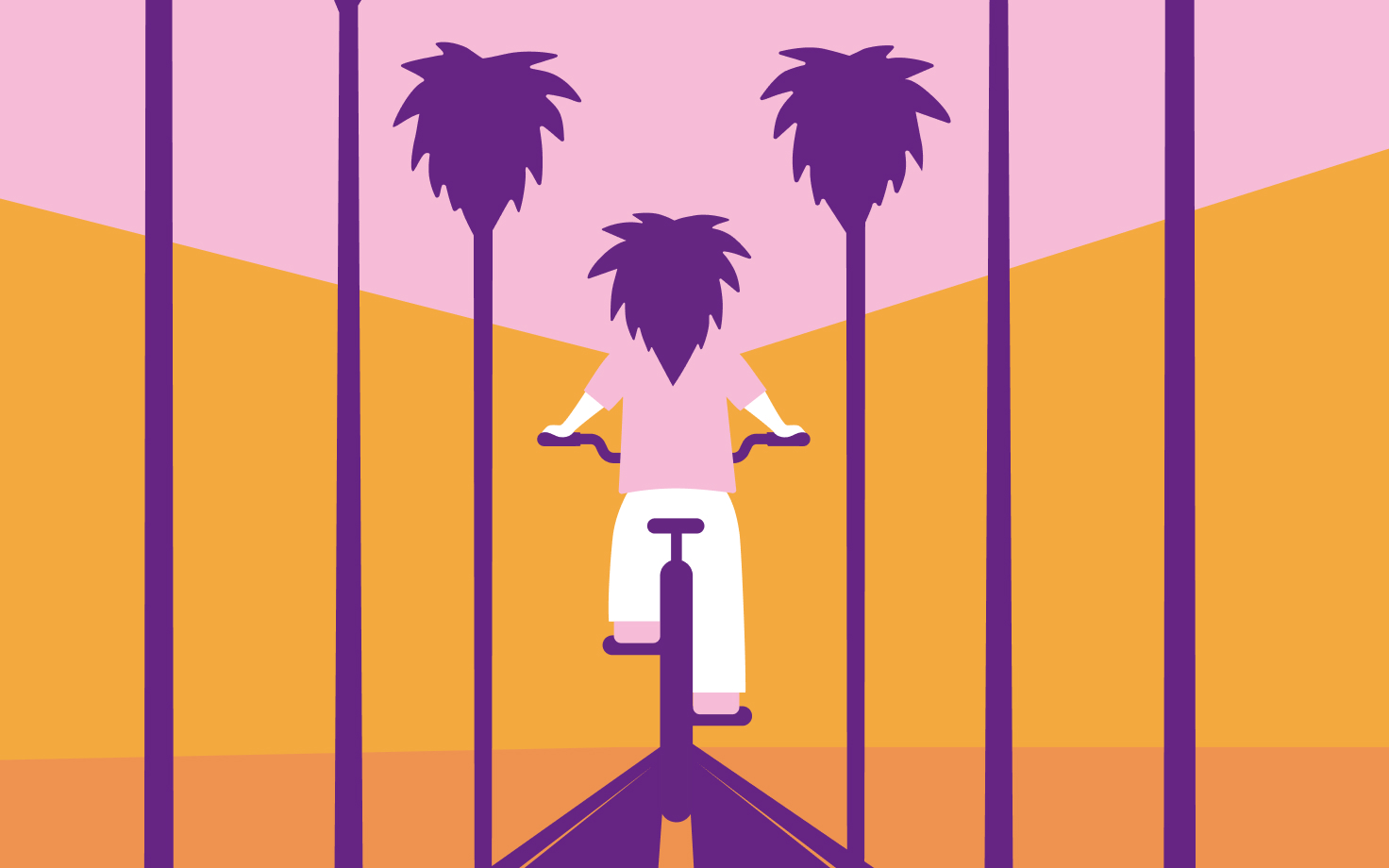With a mild climate and miles of flat streets, Los Angeles should be a paradise for pedestrians and cyclists.
Instead, the city’s relentless traffic, potholed streets and broken sidewalks have contributed to gruesome and often fatal crashes involving bikers and pedestrians, discouraging even those with easy commutes from leaving their cars behind.
And the more we drive, the more treacherous the streets become for those walking or pedaling.
Breaking this vicious circle is possible, according to a new study from UCLA’s Institute for Transportation Studies, said Adam Millard-Ball, the institute’s director and a Luskin School urban planning professor who directed the project.
The analysis, which included data from 11,500 cities around the world, concludes that increasing urban density and designing safer streets are the two most effective ways to encourage more people to walk and bike.
The potential payoff is huge: Getting more people out of their cars generates lower green-house gas emissions and improves health. At the same time, making streets safer does not usually require complex engineering projects with hefty price tags.
Dangers and the need for “mode shift”
What’s needed is a “mode shift,” said Damian Kevitt, who founded Streets Are For Everyone (SAFE) after a car hit him while he was cycling in Griffith Park. Kevitt barely survived. He lost his right leg.
The driver who hit him did not stop.
“We’re trying to get people to think differently about driving,” Kevitt said. “It shouldn’t be the first option.”
But “mode shift” has proven to be a tough sell in L.A.
Released in June, UCLA’s “Beyond Copenhagen” report offers a guide for city leaders in California and beyond. Rather than a one-size-fits-all solution, the study highlights a range of changes that cities as diverse as Nairobi, Kenya; Osaka, Japan; and Hoboken, New Jersey, have made to their streets to protect and encourage walkers and bikers.
These findings should spur Los Angeles officials to fulfill promises of safer streets made a decade ago — pledges that bike activists say officials have slow-walked ever since.
What is the best city in the world for cycling?
The question, part of Luskin’s 2023 Super Quiz Bowl, helped focus the analysis as data collection ramped up.
Millard-Ball, a faculty adviser with the annual student trivia competition that year, was intrigued. How should we define “best,” he wondered. What factors should be part of that designation?
Amsterdam, Holland, and Copenhagen, Denmark, readily came to mind as quintessential examples, with their miles of protected bike lanes, ample public racks and other changes to encourage safe walking and cycling.
But Millard-Ball, a British native who joined UCLA in 2021, and a team of international researchers wanted to look farther afield. Wire thin with colorful socks, Millard-Ball cycles to UCLA from his Westwood home. He is well acquainted with the cracked and bumpy asphalt on L.A. streets and, since adopting a dog, says he pays attention to the state of its sidewalks as well.
Using a proprietary Google dataset, the researchers analyzed travel patterns in more than 11,500 cities across 121 countries, encompassing 41% of the world’s population. They modeled the relationship between the share of kilometers traveled by bicycle and on foot and a series of city- and country-level variables.
The result is the most wide-ranging global assessment to date of the potential for walking or biking — also known as “active transportation.”
And the winner is…
If every city expanded its bike lane network and redesigned its streets as sensibly as Copenhagen, the team concluded, walking and biking rates would increase by 412 billion miles per year (or 663 billion kilometers). Getting people out of their cars could produce an estimated 6% drop in carbon emissions worldwide and $435 million in health benefits.
The “Copenhagen” team also highlighted success stories from eight very different cities that have made their streets safer and encouraged more riders and walkers.
These case studies demonstrate that street design doesn’t need to be bespoke, but it does need to align with local travel patterns.
Indeed, the elements of success are common across very different cities: a well-maintained network of bike lanes separated from car traffic and laid out along established commute routes; bus stops that accommodate wheelchairs and provide shade; sidewalks in good repair; crosswalks with flashing lights to slow cars; and “slow streets” that restrict vehicle speed or prohibit cars.
Denser cities also encourage walking because the grocery store or library may be nearby, Millard-Ball said.
The “Copenhagen” team found that weather was not an obstacle when streets were well designed. In fact, they discovered some of the highest rates of walking and biking in cities with extreme climates, including Montreal, Canada, with its long, snowy winters, and hot, humid Kolkata, India, and Dhaka, Bangladesh.
However, the sort of improvements outlined in the UCLA report, especially those that eliminate vehicle lanes, can cause fierce backlash. During the addition of protected bike paths in Playa del Rey and Mar Vista in 2017, removal of a car lane so angered neighbors, who felt the changes appeared without local input, that they attempted to recall then-L.A. City Council member Mike Bonin.
The recall effort failed, but L.A. crews nonetheless quickly restored the second Playa del Rey car lane.
State and local officials often insist that they want safer streets, but, as Millard-Ball notes, with so much of the finite “real estate” on each street given over to car travel, they have become “hostile places to bike and walk.”
Deaths and serious injuries involving pedestrian and bike commuters shot to record highs nationwide during COVID, according to data from UC Berkeley, with notable spikes in Los Angeles and the Bay Area.
Pedestrian and cyclist crashes dipped in many cities as the pandemic eased, but Los Angeles remains an unfortunate outlier. In L.A., statistically close to two bicyclists were killed or seriously injured every week last year, and nearly two pedestrians per day were killed or seriously injured, according to Los Angeles Police Department records.
In 2015, then-L.A. Mayor Eric Garcetti signed onto Vision Zero, an international network of cities committed to eliminating traffic fatalities and severe injuries by 2025. In Los Angeles, Vision Zero incorporated a public awareness campaign, as well as hundreds of infrastructure improvements over 10 years, when each street was scheduled for resurfacing.
But the public outcry over the Westside bike-ways, part of a citywide mobility plan adopted in 2015, “scared the bejesus out of every councilmember,” Kevitt said, dissuading them from pushing similar changes elsewhere.
Without those changes, Los Angeles will not realize the benefits in cleaner air and improved health that the “Copenhagen” report predicts.
The fate of “Vision Zero”
Street crews have “implemented over 7,000 safety treatments” since 2017, according to Colin Sweeney, an L.A. Department of Transportation spokesman. Those changes have “improved safety” at those sites, he said, with many other projects in the pipeline.
But Alexandra Ramirez, who heads Los Angeles Walks, called Vision Zero “a huge failure.”
“The first outcome was zero fatalities,” she said, but crashes have risen substantially.
Damian Kevitt, among others, sees better public outreach as a key to more rapid and lasting infrastructure change, but he says it should be part of what he calls the “five e’s”: engineering, enforcement, equity, evaluation, and education.
Ramirez emphasizes design over behavior. Her group trains volunteers, or promotores from low-income communities with high pedestrian deaths, to navigate city agencies and lobby for street improvements.
“At the end of the day,” she said, “people are pretty self-interested.” With the right design, drivers will slow down, “so we don’t have to focus on people doing the right thing.”
Los Angeles voters underscored the need for safer streets last year by approving Measure HLA — Healthy Streets L.A. The measure directed the city to make more progress implementing its comprehensive 2015 mobility blueprint.
HLA requires city crews to gradually add hundreds of miles of bike and bus lanes, among other improvements, as each street is scheduled for resurfacing. The initiative allows residents to sue for noncompliance.
Joe Linton, a local bike activist, filed the first lawsuit in April, saying that when the city repaved part of Vermont Avenue near his home late last year it failed to make several bike and bus enhancements specified in the 2015 mobility plan. Following the first hearing, in September, the judge issued a tentative ruling allowing LA Metro to join the case on the city’s behalf as the transit agency had asked.
As the Trump administration backs away from long-standing environmental commitments, the ability to move “beyond Copenhagen” now rests with city leaders and with activists like Ramirez and Kevitt.
Perhaps the socks Millard-Ball wore for a June interview — yellow suns poking through clouds — are a measure of his optimism.

























